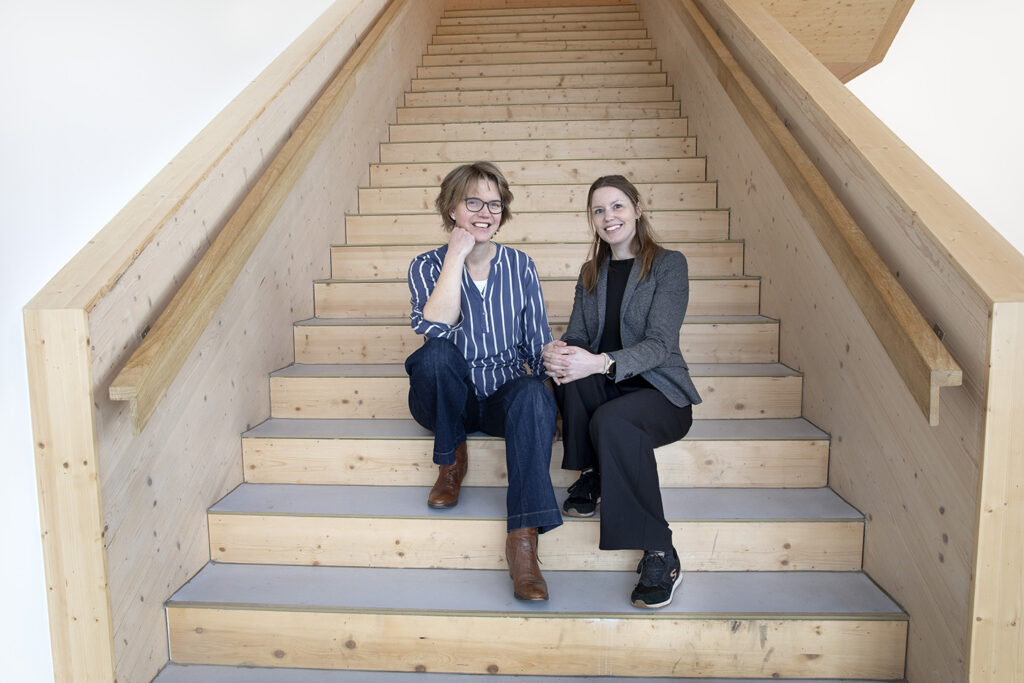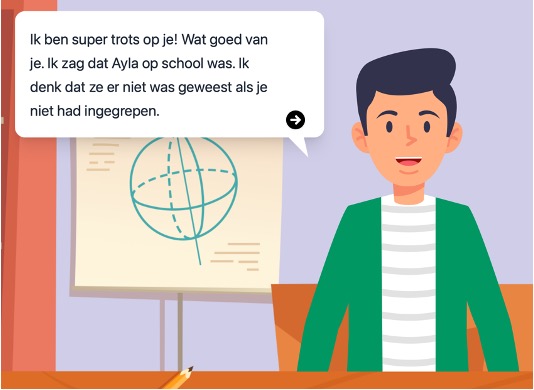Stopping cyberbullying with a good story: ‘You learn how you can do something as a bystander’
Nude photos circulating on Snapchat, hurtful comments under a photo, or excluding a classmate online: cyberbullying is a major problem. How can you prevent it? Researchers Renske van Enschot and Sara Pabian developed an interactive story in which bystanders are the key.

Imagine: you’re walking through the busy hallways of a high school. Together with your friends Jasmine, Jonathan and Max, you’re chatting about this morning’s lesson and what’s going around in the group chat. Then math class starts. As the teacher starts the lesson, a new face enters the classroom: Ayla. She’s smart, but because she’s new to the class, you can tell she’s vulnerable. Soon, your friends start making seemingly innocent jokes, which Ayla laughs at awkwardly.
But it doesn’t take long for the jokes to get sharper and more venomous. Her name starts popping up online more often, not always in a nice way. An intimate photo that’s circulating, a hurtful message in the group chat. No one really seems to say anything about it.
No, this isn’t a script for a new TV series about secondary education. This is the start of an interactive story about cyberbullying. A story in which you – as a ‘player’ – determine how it goes. Your choices make the difference: will you help someone who is being excluded? Do you speak out when an offensive message goes viral? And what role do you take within the social dynamics of the class?
By playing the game, you experience how peer pressure works and how bullying leaves deep scars. But above all: you learn how you as a bystander can do something against cyberbullying.

In this interview, Univers speaks with two researchers behind this unique gaming experience: Renske van Enschot and Sara Pabian, both university lecturers at Communication and Information Sciences. They worked in a multidisciplinary team with scientists Jan de Wit, Thorsten Erle, Marije van Amelsvoort, Eefje van Moorsel and Bianca Sips. How can this interactive way of learning contribute to a safer online climate?
What exactly did you research?
Van Enschot: ‘For centuries, stories have played an important role in how we share information and learn. In this project, we use digital media to tell a story about cyberbullying in a new way: we ask the reader to not only listen passively, but also to actively participate. By making choices themselves, it becomes an interactive experience that resembles a game.
‘For our research, we visited first-year and second-year classes and asked students to read our story and fill out a questionnaire. Not all students read our interactive story; in some classes, students read a traditional story about cyberbullying, while others were given a flat, informative text. This allowed us to determine how effective the interactive story was.
‘Students who played the interactive story indicated that they better understood how to act in such a situation. They felt more prepared to intervene or offer support, in contrast to students who only read a traditional story or informative text.’
When do we speak of cyberbullying?
Pabian: ‘We only speak of cyberbullying when the perpetrator intends to hurt someone. If someone makes an unpleasant remark without intending to hurt, that is not cyberbullying. In that case, it is more a matter of inappropriate behavior, in which the perpetrator is not aware of the impact of his or her words in that context.
‘In addition, the inappropriate behavior must occur repeatedly. A one-off hurtful message does not directly fall under cyberbullying. But when someone is systematically attacked or excluded, we do speak of cyberbullying.
‘Power inequality also often plays a role. For example, perpetrators have a strong position within a group, while the victim is more vulnerable. In the interactive story, we see this reflected in Ayla, the new student who had not yet found her place in the class. She is bullied by classmates who already fit in well with the group. That power difference makes it even more difficult for her to defend herself.’
How common is cyberbullying?
Pabian: ‘It is a major and common problem, especially among children and young people. We know from recent studies that one in ten young people between the ages of ten and fourteen has experienced cyberbullying in the past three months.
‘The consequences should not be underestimated: anxiety, depression and social withdrawal can seriously hinder young people in their development. The digital world is an integral part of young people’s lives, but it is essential that they can move around safely in it; social interaction – both online and offline – is crucial for healthy growth.
‘As a bystander, you have more influence than you think. Yet most people do not intervene in online bullying. For a victim, this feels like tacit approval, which only increases the pain and loneliness. Cyberbullying often happens in public, with many witnesses. That is why it is crucial to get bystanders to take action.’

How does this interactive game help students better recognize and respond to cyberbullying?
Van Enschot: ‘It can be extremely effective. In our interactive story, students participate under their own name, make choices from the perspective of a bystander and are directly confronted with the consequences of those choices. This makes someone much more responsible for the decisions, because you experience the impact yourself.’
Pabian: ‘One of the biggest challenges is that young people often do not know how to respond as a (digital) bystander. The interactive story teaches them to recognize what online bullying behavior is and also how they can respond to it effectively as a bystander.
‘In general, this means: do not respond aggressively, but for example report the problem to a social media platform or seek help from an adult. We know from scientific research that this type of positive bystander action can reduce or even stop cyberbullying.’
Discover how you as a bystander can make a difference in cyberbullying? Or curious about the interactive story? Take a look at: tiltale.com/cidn






